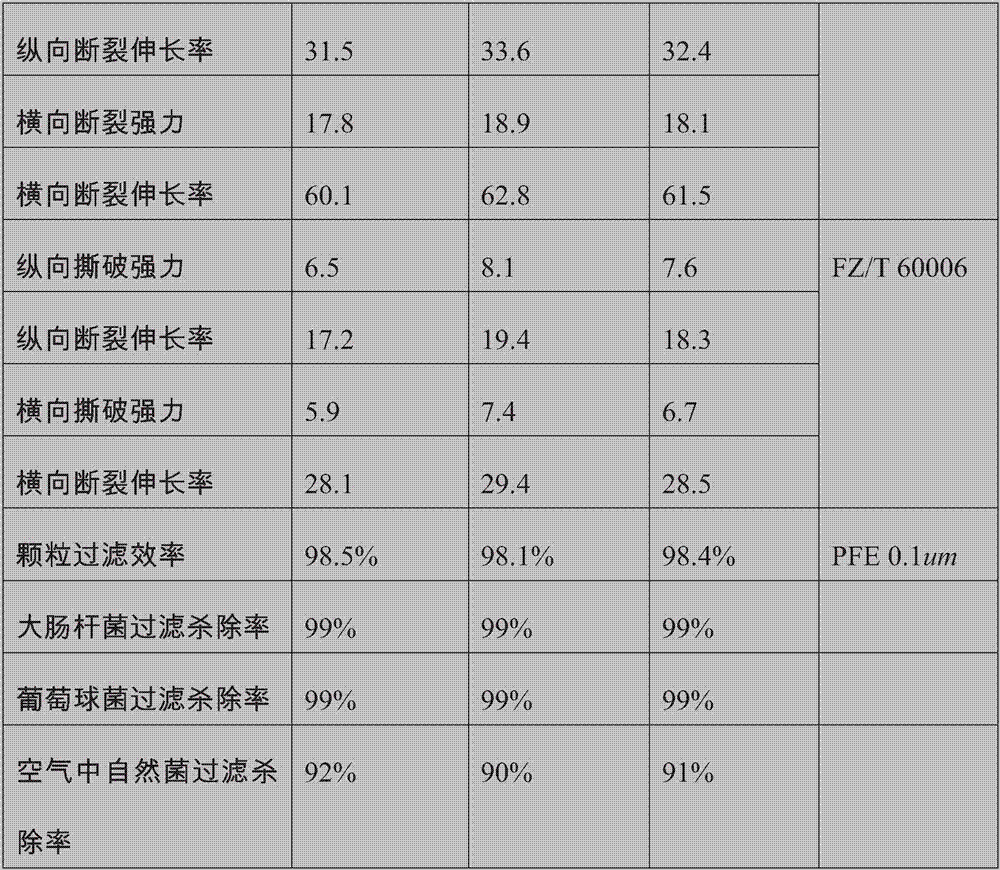Nano modified melt-blown nonwoven fabric material and manufacturing method thereof
A melt-blown non-woven fabric and nano-modification technology, which is applied in the field of filter materials, can solve the problems of poor mechanical properties, low strength, and poor wear resistance of melt-blown fabrics, and achieve high-strength mechanical properties, good mechanical properties, and mechanical properties. good performance
- Summary
- Abstract
- Description
- Claims
- Application Information
AI Technical Summary
Problems solved by technology
Method used
Image
Examples
Embodiment 1
[0051] 1) Selecting nano silicon dioxide with a particle size of 20-25nm and titanium dioxide with a particle size of 5-10nm; drying at a temperature of 120°C to remove moisture;
[0052] 2) Uniformly dissolving nano-silica and nano-titanium dioxide in toluene at a mass fraction of 1% and 4% respectively, and then adding 0.2% mass fraction of a coupling agent;
[0053] 3) Use ultrasonic mixing and oscillation for 20 minutes;
[0054] 4) Put the mixed solution in a water bath reflux reaction device, react for 180 minutes, and the temperature is 95°C;
[0055] 5) washing with absolute ethanol and drying after suction filtration to obtain modified nano-silica and nano-titanium dioxide;
[0056] 6) Mix the modified nano-silica and nano-titanium dioxide mixture with polypropylene chips at a mass percentage of 5%, and make polypropylene melt-blown non-woven fabrics through melt-blown nonwoven molding equipment;
[0057] 7) Electret treatment is carried out on the non-woven fabric ...
Embodiment 2
[0060] 1) select nano silicon dioxide with a particle size of 20-25nm, and titanium dioxide with a particle size of 5-10nm; dry at a temperature of 100°C to remove moisture;
[0061] 2) Uniformly dissolving nano silicon dioxide and nano titanium dioxide in toluene at a mass fraction of 6% and 1% respectively, and then adding 0.3% mass fraction of a coupling agent;
[0062] 3) Use ultrasonic mixing and oscillation for 20 minutes;
[0063] 4) Put the mixed solution in a water bath reflux reaction device, react for 180 minutes, and the temperature is 95°C;
[0064] 5) Clean and filter with absolute ethanol and then dry;
[0065] 6) Mix the modified nano silicon dioxide and nano titanium dioxide mixture with polypropylene slices at a mass percentage of 8%, and make polypropylene melt blown nonwoven fabric through melt blown nonwoven forming equipment;
[0066] 7) Electret treatment is carried out on the non-woven fabric through a corona electret process to obtain a nano-modified...
Embodiment 3
[0068] 1) select nano silicon dioxide with a particle size of 20-25nm, and titanium dioxide with a particle size of 5-10nm; dry at a temperature of 140°C to remove moisture;
[0069] 2) Uniformly dissolving nano-silica and nano-titanium dioxide in toluene at a mass fraction of 3% and 2%, respectively, and then adding a coupling agent of 0.1% mass fraction;
[0070] 3) Use ultrasonic mixing and oscillation for 40 minutes;
[0071] 4) Put the mixed solution in a water bath reflux reaction device, and react for 200 minutes at a temperature of 105°C;
[0072] 5) Clean and filter with absolute ethanol and then dry;
[0073] 6) Mix the modified nano silicon dioxide and nano titanium dioxide mixture with polypropylene slices at a mass percentage of 4%, and make polypropylene melt blown nonwoven fabric through melt blown nonwoven forming equipment;
[0074] 7) Electret treatment is carried out on the non-woven fabric through a corona electret process to obtain a nano-modified melt-b...
PUM
| Property | Measurement | Unit |
|---|---|---|
| particle diameter | aaaaa | aaaaa |
| particle diameter | aaaaa | aaaaa |
| particle diameter | aaaaa | aaaaa |
Abstract
Description
Claims
Application Information
 Login to View More
Login to View More - R&D
- Intellectual Property
- Life Sciences
- Materials
- Tech Scout
- Unparalleled Data Quality
- Higher Quality Content
- 60% Fewer Hallucinations
Browse by: Latest US Patents, China's latest patents, Technical Efficacy Thesaurus, Application Domain, Technology Topic, Popular Technical Reports.
© 2025 PatSnap. All rights reserved.Legal|Privacy policy|Modern Slavery Act Transparency Statement|Sitemap|About US| Contact US: help@patsnap.com


